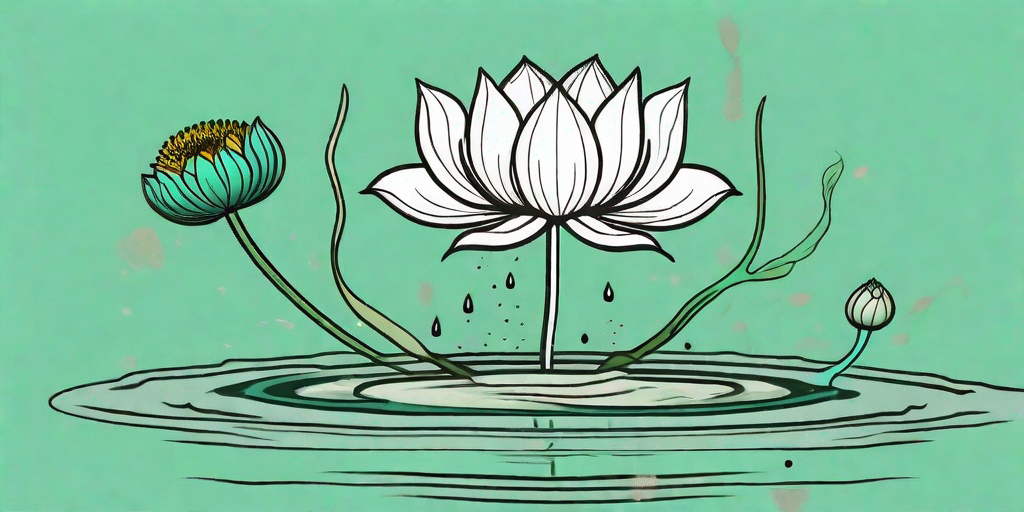
The lotus flower, a symbol of purity and enlightenment in many cultures, has a life cycle unlike any other. With its roots based in mud, it submerges every night into murky river water, only to rebloom the next morning without any residue on its petals. An absolute spectacle, isn't it? But how does this muddy marvel transform into a magnificent bloom? Let's dive in, shall we?
The Life Cycle of a Lotus Flower
Stage One: The Seed
Like any great story, the journey of the lotus flower begins with a tiny seed. This seed can remain dormant for many years before beginning its growth. In fact, a lotus seed as old as 1300 years was successfully germinated in a laboratory. Now, that's what I call a late bloomer!
Once conditions are right, the seed begins to sprout, sending out roots to anchor itself in the muddy bed of its watery home. The seedling then sends up a shoot towards the water's surface, where it will soon break through into the light.
Stage Two: The Bud
After breaking the surface, the lotus continues to grow, producing a bud. This bud is initially protected by a sheath, which falls off as the bud grows. The bud continues to grow towards the light, preparing to bloom into a beautiful flower. It's like the flower version of a teenager, all awkward and gangly, but full of potential.
Once the bud has reached its full size, it begins to open. This process can take up to three days. Talk about a dramatic entrance!
Stage Three: The Bloom
Once the lotus flower has fully opened, it reveals a stunning array of petals and a central pod. This pod contains the flower's reproductive organs, and is often used in dried flower arrangements or for its edible seeds. It's the flower's way of saying, "Hey, look at me! I'm ready to make some baby lotuses!"
After a few days, the petals begin to fall off, leaving the pod exposed. The pod matures and the seeds within it begin to grow. Once the seeds are mature, they are released into the water, ready to begin the cycle anew. And thus, the circle of life continues.
Symbolism of the Lotus Flower
In Buddhism
The lotus flower is a significant symbol in Buddhism, representing the journey to enlightenment. The growth of the lotus, with its roots in mud, blooming through the water and emerging at the surface, symbolizes the journey of the soul from the mud of ignorance, through the waters of experience, and into the sunshine of enlightenment. Deep stuff, right?
Each color of the lotus also has its own symbolism. For example, a white lotus symbolizes purity of mind and spirit, while a red lotus represents love and compassion.
In Hinduism
In Hinduism, the lotus flower is associated with beauty, fertility, prosperity, spirituality, and eternity. Many of the gods and goddesses of Hinduism are depicted sitting on a lotus flower, symbolizing divine beauty and purity. It's like the VIP lounge of the spiritual world.
The lotus is also associated with the chakras, or energy centers, within the body. The crown chakra, for example, is often depicted as a lotus flower with a thousand petals, representing the ultimate state of enlightenment.
FAQs
- How long does a lotus flower live?
- A lotus flower can live for over a thousand years. Yes, you read that right. A thousand years! That's older than your great-great-great-great-great-great-great-grandma.
- Can you eat lotus flowers?
- Yes, you can! Lotus seeds and roots are often used in Asian cuisine. They're said to taste a bit like a sweet potato. So, if you're ever lost in a swamp, you know what to look for.
- Can I grow a lotus flower at home?
- With the right conditions, yes, you can grow a lotus flower at home. They need plenty of sunlight and a good amount of space, so a large, sunny pond or a big container of water would be ideal. Just remember, patience is key. These flowers aren't known for their speed.
Conclusion
From its humble beginnings in the mud to its glorious bloom above the water, the journey of the lotus flower is truly a fascinating one. It's a journey of transformation, of resilience, and of beauty. It's a reminder that even in the muddiest of circumstances, there's always the potential for something beautiful to grow.
So, the next time you see a lotus flower, take a moment to appreciate its journey. And remember, like the lotus, we too have the ability to rise from the mud, bloom out of the darkness, and radiate into the world. Now, isn't that a blooming marvelous thought?















